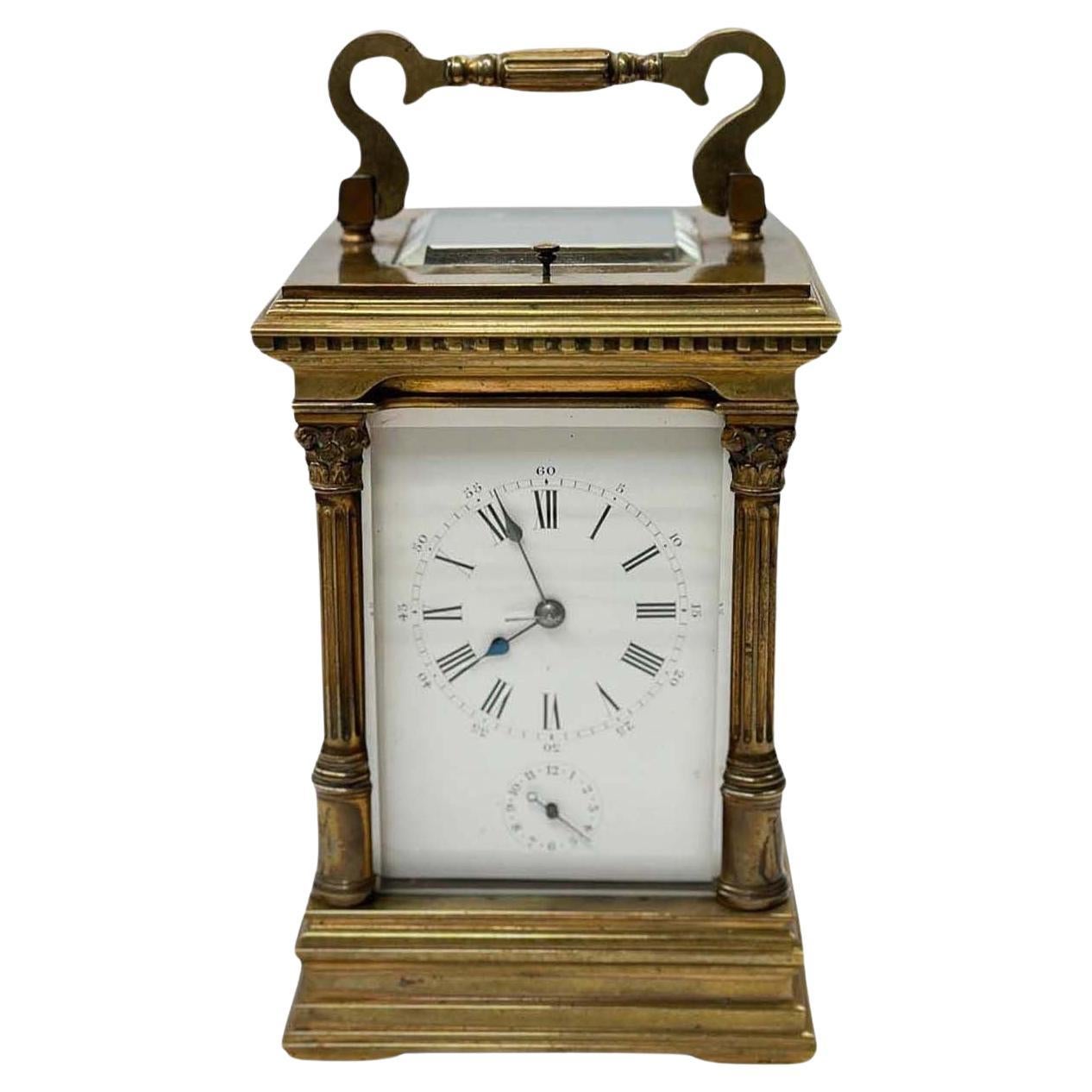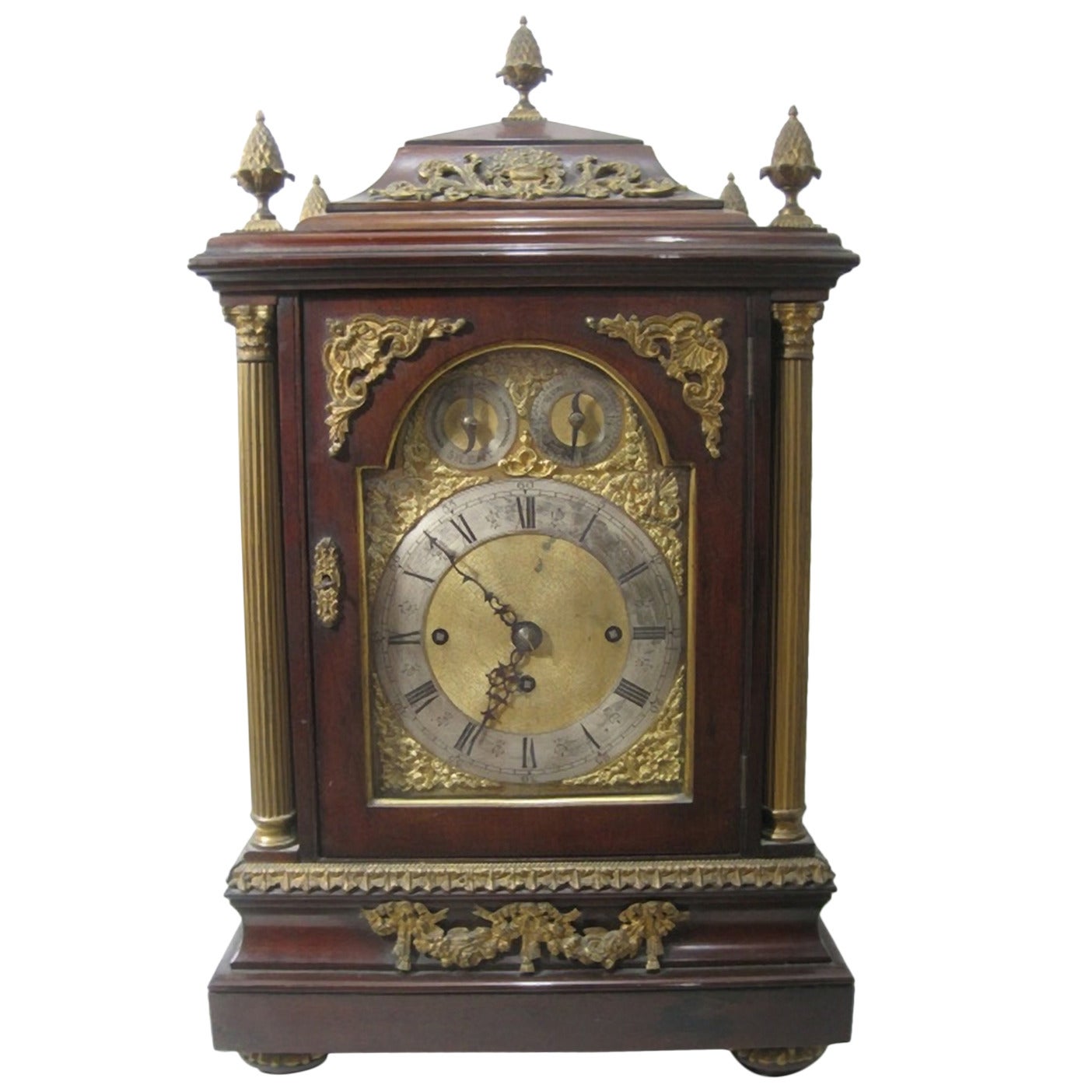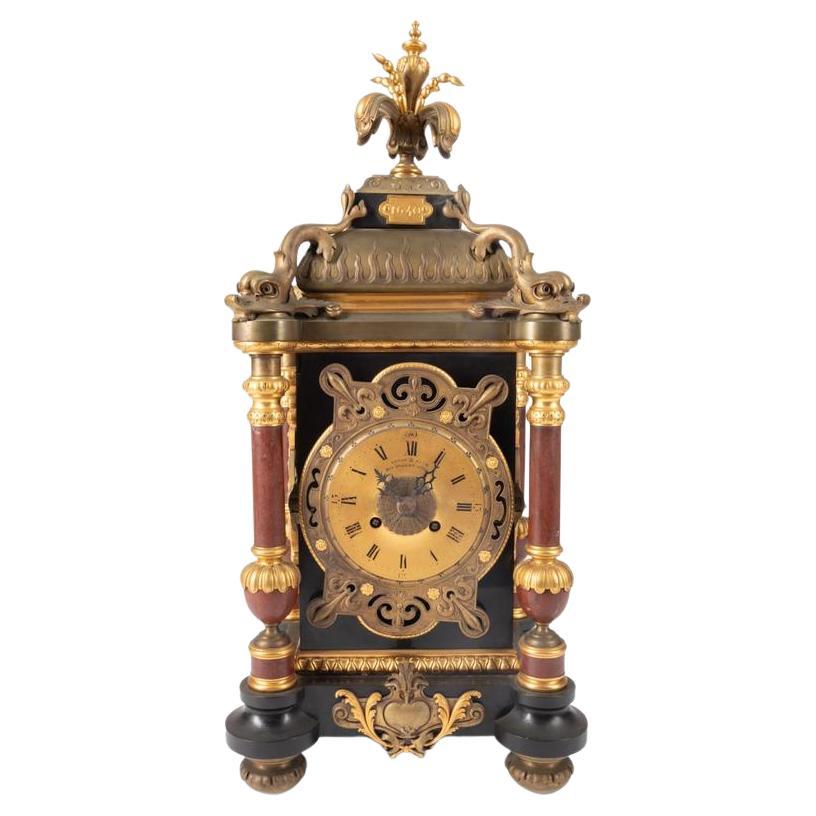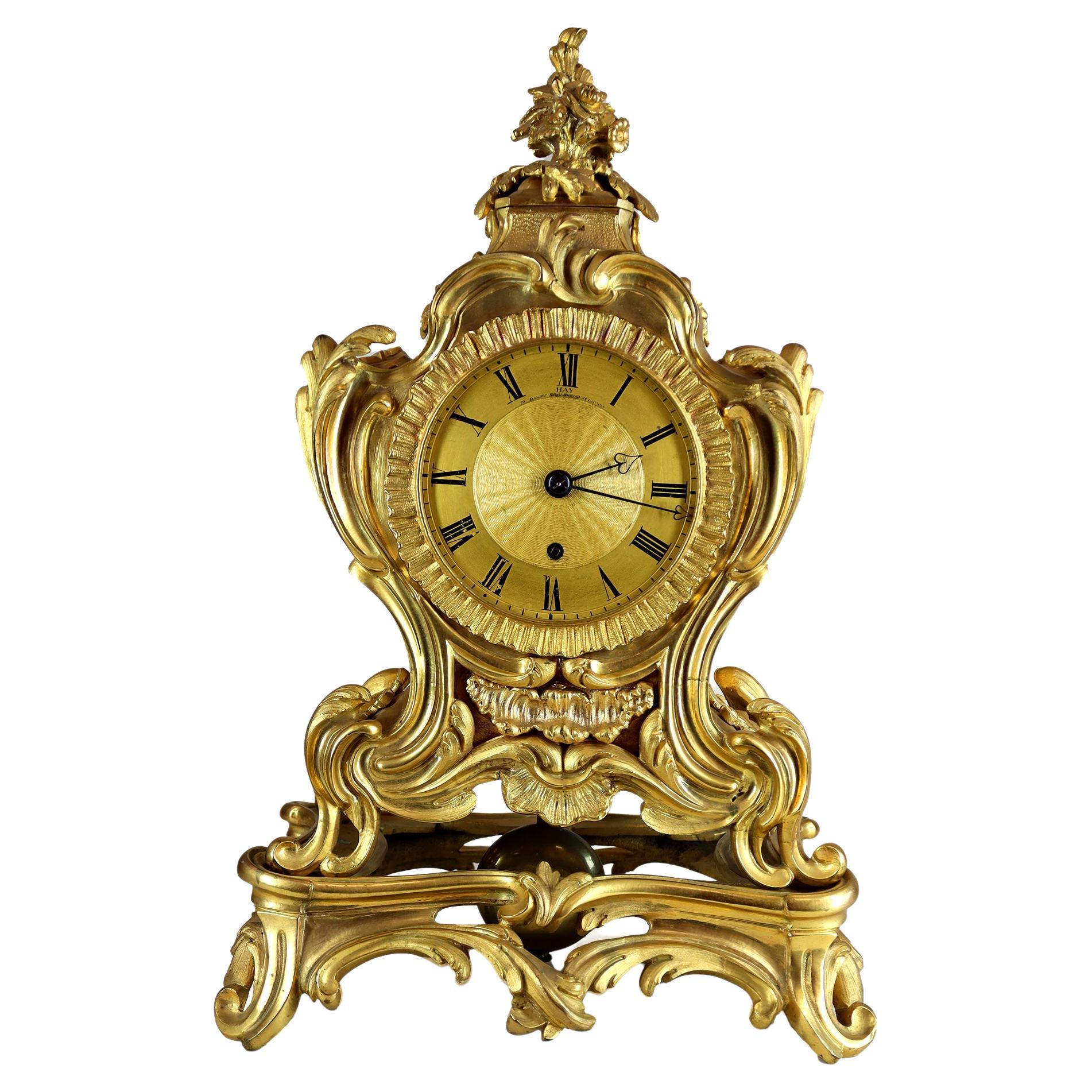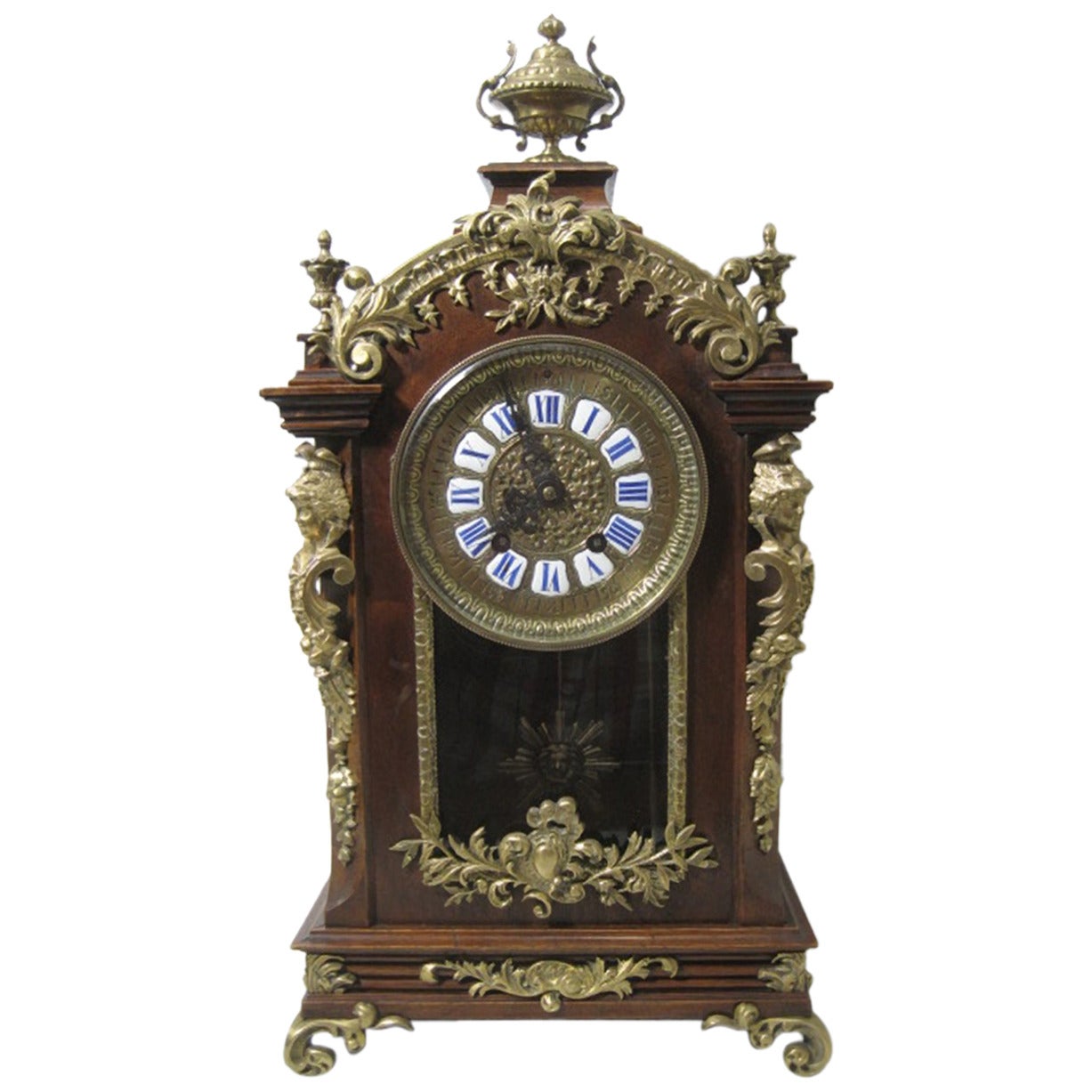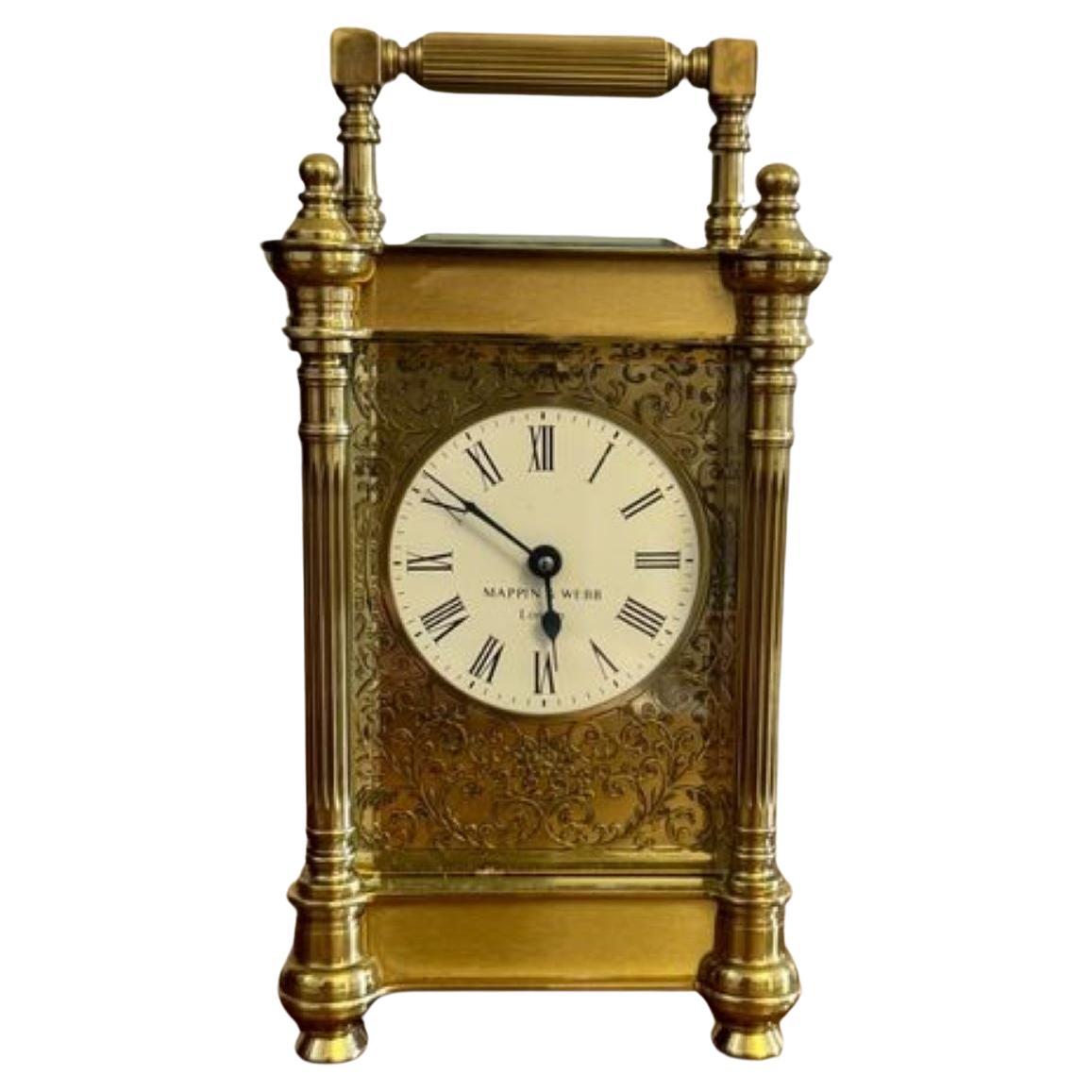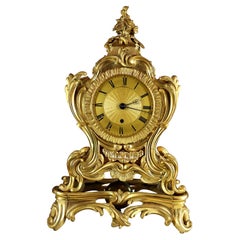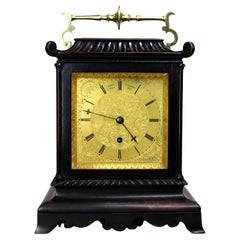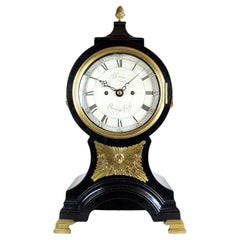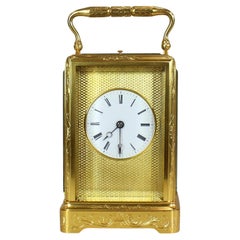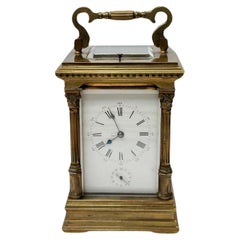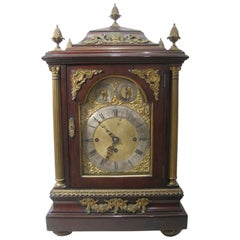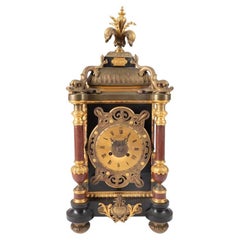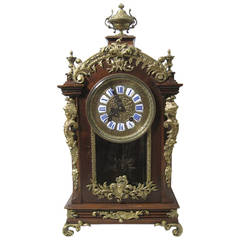Items Similar to A Unique Twin Fusee English Carriage Clock by James Moore French
Want more images or videos?
Request additional images or videos from the seller
1 of 17
A Unique Twin Fusee English Carriage Clock by James Moore French
$21,201.75
£15,525
€18,072.05
CA$29,209.29
A$31,832.98
CHF 16,856.94
MX$382,347.64
NOK 213,412.54
SEK 196,211.84
DKK 134,978.19
About the Item
A one of a kind english twin fusee carriage clock by James Moore French. The eight day movement has a large English jewelled level escapement with compensated bimetallic balance. The movement is wound and set through a round glazed door at the back and can be regulated from the outside as the fast/slow arm extends through the back of the case with rack striking the hour and half hour on blued steel gong with trip repeat.
The gilt dial is signed as is th back plate of the movement, the centre of the dial is engraved with foliate scroll work with a roman chapter and breguet style moon hands.
The unusual case of case bronze in a rococo revival style is finely chased with fluted sides flanked by Cariatids with a swag of fruit and flowers strung between them, th handle is formed of two dolphins.
James Moore French was born in 1781 in County Antrim, Ireland. He was the son of Dr Hugh French and Sarah (née Arundel) French who married his father in 1763 and died in 1783, two years after James’s birth. In 1784, the year after Sarah’s death, Dr Hugh French married a widow named Judith Woodward who was to raise the young James French as her own, alongside his own and his half siblings. As a young man, James French moved from Ireland to London, where he worked with a relative, Peter Moore, who was a watch and clockmaker based at 15 Sweetings Alley, just off Cornhill on the eastern side of the Royal Exchange, in the City of London.
In 1810 French was admitted to the Worshipful Company of Clockmakers, by which time he appears to have taken over Moore’s business and premises, commencing trading as James Moore French of Sweetings Alley. Certainly, we know that he was trading from 15 Sweetings Alley from 1808 until about 1838. A London trade directory dated 1829 has a listing for J. M. Moore advertising as a chronometer maker at 14 and 15 East side of Royal Exchange (i.e., Sweetings Alley). By 1839 he had moved to 18 Cornhill and is also recorded at 86 Cornhill, during 1839-40, and from 1841 up until his death in 1842 at 80 Cornhill. It seems that in 1825, and for a short time, he was in partnership with Mr. Mitchell at 5 Clerkenwell Close, when they traded under the name of Mitchell & French. On other occasions, he was referred to under the name of Santiago James Moore French or simply Santiago Moore French, particularly when trading clocks with Spain.
During the 1820s, James Moore French diversified into the manufacture of marine chronometers, at which he excelled, winning various prizes from the Board of Longitude. For instance, he submitted chronometers to the trials at the Royal Observatory Greenwich between 1822 and 1825, winning two Admiralty prizes in 1825, while George Cruikshank’s portrait engraving of him, showing him proudly standing beside one of his prize chronometers, (published in 1827; of which there is an example in the British Museum, London), is titled below The Royal Exchange Triple Prize Chronometer. Furthermore, his chronometer no 4214 was used on one of Charles Darwin’s voyages on HMS Beagle (Darwin being the famous author of On the Origin of Species).
For a period, James Moore French lived in Islington and then later at Perry Hill House, near Lewisham, a beautiful late eighteenth century mansion, set in its own parkland. By the time of the 1841 census, he was living in Stockwell Place with his wife Elizabeth and a number of their children. They had at least six offspring of whom John and William followed their father’s profession and who, according to his will, were left his business after his death. James Moore French died in late January 1842, and was buried on 3rd February 1842, in Norwood Cemetery, south London. Even though his will stated that he was to leave the business to his sons William and John, it appears that it was continued by his widow and the Spanish-born clockmaker Jose Rodriguez Losada, who had previously worked for French and later married his widow. Under Losada, the firm continued to produce many fine clocks and chronometers selling, in 1864, thirty-eight examples to the Spanish government after successfully competing in trials. During this period the shop in Cornhill (called The City Observatory) was equipped with a large time ball which received signals from the Electric Telegraph Company to enable the public to check their watches. A picture of French’s shop and time ball appears in Vaudrey Mercer’s biography of the renowned clockmaker Edward John Dent and his successors.
- Creator:Santiago James Moore French (Clockmaker)
- Dimensions:Height: 9.06 in (23 cm)Width: 7.49 in (19 cm)Depth: 4.14 in (10.5 cm)
- Style:Rococo Revival (In the Style Of)
- Materials and Techniques:
- Place of Origin:
- Period:
- Date of Manufacture:Circa 1840
- Condition:Wear consistent with age and use.
- Seller Location:Amersham, GB
- Reference Number:Seller: 3061stDibs: LU9135240632272
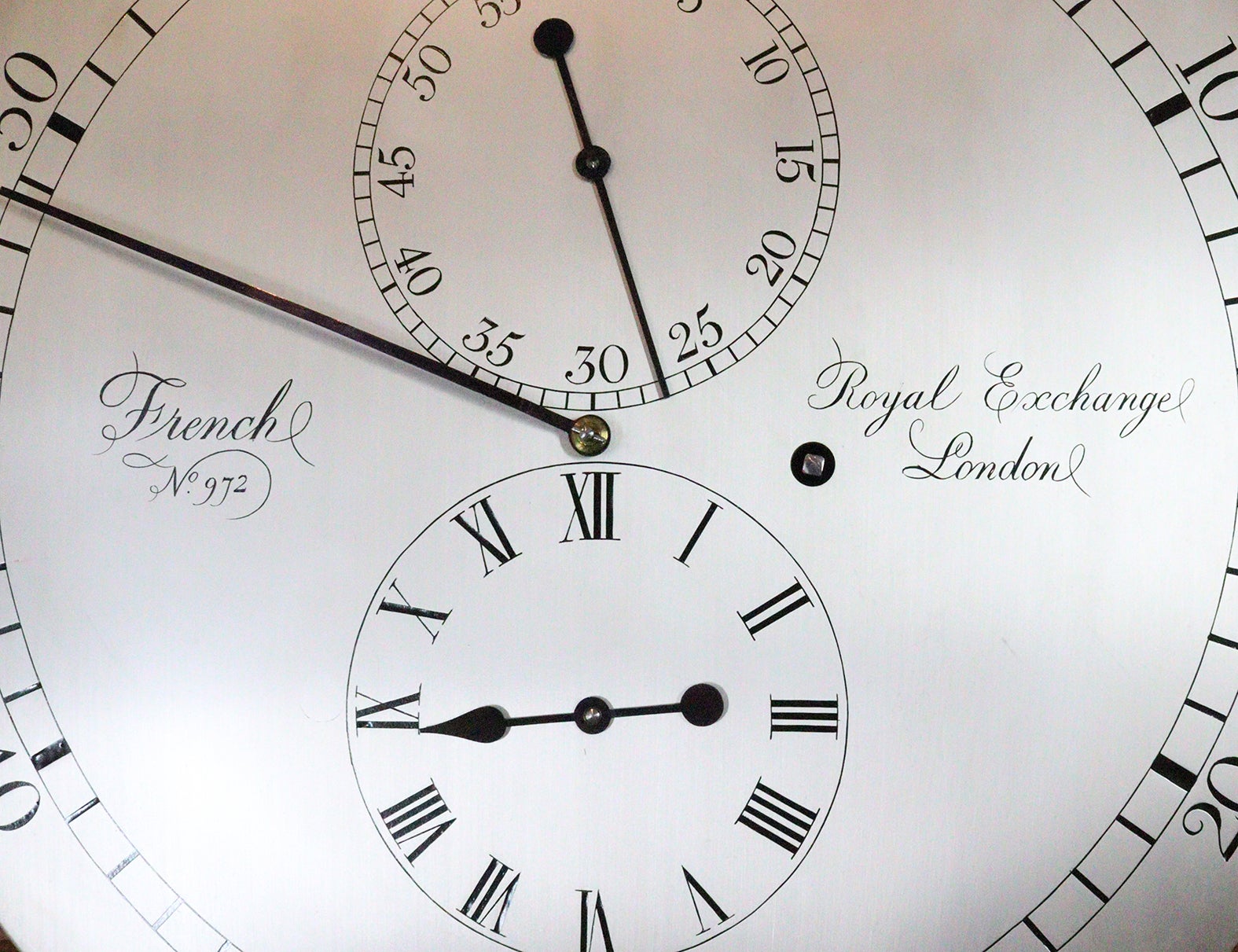
About the Seller
No Reviews Yet
Vetted Professional Seller
Every seller passes strict standards for authenticity and reliability
Established in 2021
1stDibs seller since 2023
7 sales on 1stDibs
Typical response time: 3 hours
- ShippingRetrieving quote...Shipping from: Amersham, United Kingdom
- Return Policy
More From This Seller
View AllSingle Fusee Mantel clock by Hay London
By HAY
Located in Amersham, GB
An unusual english single fusee mantel clock in a Louis XV style rocaille ormolu case in the french taste. The eight day fusee movement is of superb quality with a pendulum descendin...
Category
Antique Early 19th Century British Rococo Mantel Clocks
Materials
Bronze
An Extremely Rare Arnold and Frodsham Carriage Timepiece
Located in Amersham, GB
This exceptional carriage timepiece made by one of Englands greatest clockmakers is highly unusual. The single fusee eight day movement regulated by a large fully jewelled lever esca...
Category
Antique 1840s English Chinoiserie Carriage Clocks and Travel Clocks
Materials
Gold, Brass
John Leroux, London. Twin Fusee Balloon Clock
By John Leroux
Located in Amersham, GB
An 18th century balloon shaped bracket or table clock by John Leroux of Charing Cross, dating from circa 1790. The waisted case surmounted by a brass pineapple finial over a drum housing the movement. The dial is behind a hinged convex glazed cast brass bezel to front and brass carrying handles to sides, over hipped concave-sided section forming the base. The front has an applied mount of a sunburst mask, the rear with keyhole shaped door incorporating fine scroll-pierced sound fret set within the frame of the case, on generous cavetto moulded skirt base incorporating break-arch recess to apron and with ogee bracket feet.
The five knopped pillar twin fusee bell striking movement with rounded angles to the rectangular plates and anchor escapement regulated by a long bob pendulum with an effective length of approximately 11.5 inches, the backplate signed J. Leroux, London to centre, the 7 inch circular single sheet silvered brass Roman numeral dial signed Leroux, Charing Cross to centre, with fine pierced steel hands and Arabic five minutes to outer track.
An identical clock is illustrated in English Bracket and Mantel Clocks by Andrew Nicholls...
Category
Antique 18th Century English George III Mantel Clocks
Materials
Brass
One Piece Engraved Repeating Carriage Clock
Located in Amersham, GB
A fine early repeating carriage clock in an engraved one piece case. With a gilt engin turned mask, and a white enamel dial and roman numerals.
The gilded case is engraved with foliate scrollwork, the 8 day repeating movement with English lever platform escapement strikes on a gong, is regulated by a silvered english lever platform escapement, although unsigned this clock is of the highest quality and is likely to have been made by one of the great Parisian makers. The gong block is signed FD in an oval cartouche, this supplier was used by both Henri Jacot...
Category
Antique 1850s French Victorian Carriage Clocks and Travel Clocks
Materials
Brass, Enamel, Steel, Ormolu
Miniature French Inlaid Religieuse Clock
By Dent
Located in Amersham, GB
Miniature Ebonised Religieuse or Bracket Clock originally sold by Dent. With engraved bone inlay, brass finials and balustrading. In the manner of a 17th century baroque clock with b...
Category
Antique 1870s French Louis XIV Mantel Clocks
Materials
Silver, Brass
Repeating Drocourt Carriage Clock with Alarm
Located in Amersham, GB
A strike repeat alarm carriage clock by Pierre Drocourt. Stamped and numbered with the Drocourt mark on the back plate in a gilded 'Gorge' case. Drocourt was one of the great carriag...
Category
Antique 1860s French Victorian Carriage Clocks and Travel Clocks
Materials
Brass, Steel, Ormolu
You May Also Like
French Early 20th Century Carriage Clock by A. Dumas
Located in Los Angeles, CA
Stunning French brass carriage clock with glass protection by A. Dumas. It is designed with four fluted columns, a dial plate with Roman numerals and more minutes above an alarm sett...
Category
Early 20th Century French Carriage Clocks and Travel Clocks
Materials
Bronze
English Bracket Clock, 19th Century Georgian
Located in Hamilton, Ontario
19th century Georgian English bracket clock.
A fine quality 8-day mahogany and ormolu-mounted triple chain Fusee 4-Gong Westminster Chime bracket clock. The high quality mahogany ...
Category
Antique 19th Century Great Britain (UK) Georgian Mantel Clocks
Materials
Brass
Le Roy & Fils Baroque Revival Partial Gilt Clock
Located in Atlanta, GA
Le Roy & Fils (French 1785), Baroque Revival parcel gilt bronze mounted and mixed marble mantel clock, mid-19th century, having a foliate finial, domed hood with plaque reading "1640...
Category
Antique 1860s Baroque Revival Mantel Clocks
Materials
Marble, Bronze
Lenzkirch Bracket Clock in French Louis XVI Style, 19th Century
Located in Hamilton, Ontario
German Lenzkirch mahogany and carved ormolu cased mantel clock. The clock has wonderful carved scrolling feet supporting a rolled ridged stepped base decorated with leaf carved ormol...
Category
Antique 19th Century German Louis XVI Mantel Clocks
Fine quality antique carriage clock by Mappin and Webb
Located in Ipswich, GB
Fine quality antique carriage clock by Mappin and Webb, having a fine quality antique carriage clock with beautiful floral fretwork frontage sur...
Category
20th Century English Carriage Clocks and Travel Clocks
Materials
Brass
A mid 19th century striking bracket clock by Charles, Nephew & Co Calcutta
Located in London, GB
A rare mid 19th Century Bracket Clock of unusual large proportions, the silvered dial 8-day quarter repeat movement striking on bells and gong, by Charles. Nephew & Co, Calcutta. Th...
Category
Antique Mid-19th Century English Early Victorian Table Clocks and Desk C...
Materials
Ebony, Giltwood
More Ways To Browse
Antique Shops France
Brass French Clock
French 19th Century Rococo Furniture Set
Antique French Brass Clocks
18th Century French Bronze Clock
Antique English Clocks
Antique Chronometer
Antique Alley
Chronometers
Gold Rococo Clock
Fusee Clock
Gold Travel Clock
Antique Fusee Clock Clocks
Gold Carriage Clock
English Fusee Clock
Antique Spanish Clocks
Marine Chronometers
Antique Marine Chronometer
